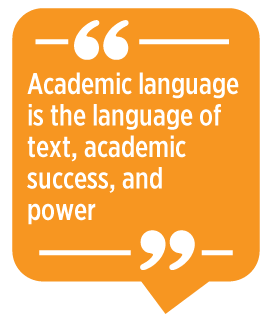|

Shawn and I met several years ago at a Wisconsin Technical
College System ESL Pro training initiative focusing on incorporating rigor into
English language instruction. Naturally, as English language instructors do, we
began sharing ideas about the needs of our learners and how we try to meet
them. Shawn works with high-level English language learners and learners in
Career Pathways Bridge Programming. I, on the other hand, work at the beginner
levels where many are just learning to read. Even though we have very diverse
groups of learners, we both saw opportunities where we could help each other.
Academic Vocabulary and Higher
Order Thinking at All Levels
One of the
many things we learned from our ESL Pro facilitator, Jayme Adelson-Goldstein,
(Lightheartedlearning.com), was that academic language is the language of text,
academic success, and power. We quickly recognized that academic vocabulary, or
lack of it, was one of the biggest challenges our learners faced. Shawn
recalls, “In my upper-level classes, learners were doing a great job every day
in the classroom and on assignments, but they just weren’t getting passing
scores on standardized tests and certification exams.”
 Shawn
continues, “Knowing that academic language promotes higher order thinking and
helps us to describe complex ideas, I knew I not only had an opportunity but an
obligation to my students to develop intentional and authentic activities
surrounding academic vocabulary.” Shawn
continues, “Knowing that academic language promotes higher order thinking and
helps us to describe complex ideas, I knew I not only had an opportunity but an
obligation to my students to develop intentional and authentic activities
surrounding academic vocabulary.”
What Shawn
Did
Wanting to
dig deeper as to why her students were struggling, Shawn looked at the tests
and found key words like analyze, contrast, and persuade. She realized the problems her learners were
having were caused more by the language in the directions than the material
itself. To address this, Shawn designed an activity to help her learners
acquire that vocabulary. She gave them a list of words from The
Top 10 Terms Students Need To Know To Be Successful on Standardized
Tests (Williams, n.d.). She asked them to find definitions
for the terms and then use them in examples related to their fields of study.
Next, she
extended the task to include critical thinking by asking her learners to tie
the terms together. For example: Analyze can be connected with compare because I need to analyze the medical test results and compare
them to normal levels. By adding this additional layer of
complexity, students not only used the terms in a contextualized manner but
they also made a connection between the terms, thereby deepening the learning.
What Carolyn
Did
As Shawn
shared her struggles and the work she was doing with her higher level learners,
it became clear to me that there was a great need to begin teaching academic
language in the lowest levels of English language instruction. Jayme
Adelson-Goldstein had often talked about this in our training, but here it was
clear as day in our classrooms. Shawn and I talked about the benefits of
introducing this language at the beginner levels to give the learners time to
acquire the skills needed to be successful.
Thinking
about my Level 1 beginners, I started to look for opportunities to teach
academic language. I was able to incorporate words like foundation,
summarize, success, habit, categorize, reason, priority, and strategy with relative ease. Though none of these words
were in our basic texts, introducing them opened up many opportunities for
level-appropriate, academic discussions and sharing of cultural expectations. I
quickly found that my adult learners understood these concepts in their own
languages, they just didn’t have the language to label or produce it in
English. That’s where I was able to step in and support them with the words
they were looking for. Talk about invigorating!
What You Can
Do
Try reaching
out to a colleague who teaches a different level. Find out what they are doing
and what is and is not working for them. Really listen. You will be surprised
at how quickly you come to an intersection. Keep brainstorming until you find a
common theme. Keep in mind you only need to choose one area to focus on so that
it is not too overwhelming. The key is baby steps. Communication is essential
for continual improvements. Celebrate your small wins!

Learner Persistence: A Daily Commitment to Learning
What Shawn
Did
Another area
that Shawn and I found we could collaborate on was learner persistence. Shawn
shares, “The level of commitment in my classes wasn’t where it needed to be for
success in the workplace and/or in postsecondary education.” So, an intentional
focus was placed on teaching employability skills (soft skills) in the
classroom. A rubric was developed and students were given points in each class
in areas such as being on time, showing up, being respectful, and communicating
effectively. Shawn said,
After
tracking the students with this rubric, we determined that attendance was the
number one reason our students were not successful in their classes. The EL
team developed a stricter attendance policy and then aligned it to the
expectations of attendance in the workplace. The attendance policy has academic
language in it so it is another great opportunity to review and define more of
that powerful language.
What Carolyn
Did
Shawn’s
struggles with learner persistence helped me to recognize that I needed to
emphasize cultural expectations about attendance in education and in the
workplace starting with my beginner learners. Making a commitment to learn a
little every day and how we handle barriers seemed like a good place for me to
start.
I’ve always
encouraged my beginners to come to school “every day, every day” and told them
that we learn best “little by little,” but I wanted them to actually experience
and then recognize it for themselves. I decided to introduce an activity that
I’ve used for a few years. Every morning, I put the alphabet on the overhead,
and we go through the long vowels and consonant sounds one by one. At first, it
takes nearly the entire hour, but with practice it takes less and less time.
Then, I start incorporating a new sound (e.g., short vowels or digraphs) each
day. By the end of the semester, my students had both listening and
pronunciation of most of the sounds of English down pat and were quite proud of
their progress. I asked them to think about what and how they learned. One said
(and I am paraphrasing) that it was like when a farmer plants seeds. It takes
daily work before you see results. Others agreed. It was exciting to be their
facilitator as they learned about learning.
Managing
barriers is also something I felt needed to be addressed with my low level
learners. It just so happened that the weather report presented itself as the
perfect opportunity this past semester. The meteorologists were predicting that
an icy snowstorm was on its way and was most likely to hit during the next
morning’s rush hour. My beginners and I brainstormed ways to get to school
during bad weather (Plan A = I drive; Plan B = I take the bus; Plan C = I call
a friend), later labeling our list items contingency
plans. That next snowy morning? We had 100% attendance and a
palpable sense of pride. Since then, when the weather threatens, I now often
hear “Well, this is Wisconsin.” I am hoping that we planted a seed of resiliency
and that it becomes ingrained so that when they do reach classes like Shawn’s,
their persistence will have simply become a habit.
What You Can
Do
Again, reach
out to a colleague who teaches a different level. Discuss learner persistence
and brainstorm employability skills for beginners through advanced levels.
Build a rubric that could be used to assess those skills throughout all levels.
Keep in mind, it is important to have discussions about consistent
reinforcement and how to hold the teachers accountable. Students appreciate
consistency whether they are beginning or advanced level.
ESL Teacher Collaboration for
Improving Practice
The
experience of working together has helped us to see the challenges at both ends
of the language learning spectrum. In addition to our day-to-day collaboration,
together we presented “Connecting Adult ELLs to Their Goals Through Increased
Rigor” at the 2018 TESOL Convention in Atlanta, Georgia, USA. Our collaboration
has allowed us to work creatively together, sharing ideas to address the needs
of our learners as they work toward reaching their goals of college, career
and/or community. So why not give it a try? Pick a partner and discover the
amazing success you and your learners can have.
Reference
Williams, K.
(n.d.). Top 10 terms students need to know to be successful on
standardized tests. Scholastic.
https://www.scholastic.com/teachers/articles/teaching-content/top-10-terms-students-need-know-be-successful-standardized-tests/
Shawn
Jensen is an English language learner and
Career Pathways Bridge instructor at Northeast Wisconsin Technical College. She
teaches upper level English language learner classes and Career Pathways
Bridge. She has been instrumental in developing the Career Pathways Bridge
programming and team teaching training for the state of Wisconsin. She has
presented on various English language learner topics at local, state, and
national conferences.
Carolyn
Nason joined Milwaukee Area Technical
College in 2005 as part-time faculty, moving to full time in 2014 and
instructional chair in 2017. She received her MA from the University of
Wisconsin Milwaukee in 2006, where she later taught (2009–2013) in the
intensive English program. At Milwaukee Area Technical College, Carolyn’s
current interests include integrating the EL program into Guided Pathways,
incorporating rigor, and contextualizing instruction especially at the
beginning levels. |